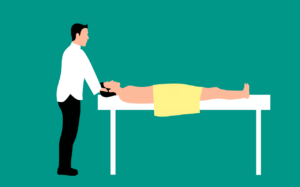
Have you ever woken up feeling groggy and achy, with a nagging pain in your arms and shoulders? If so, you’re not alone. Countless people struggle with arm and shoulder pain after a night’s sleep, and it can disrupt your day before it even begins. But fear not, because there are several effective ways to alleviate this discomfort and start your day off on the right foot. By making a few simple adjustments to your sleeping position, incorporating gentle stretches and exercises, and considering the use of heat therapy, you can find relief and regain control of your mornings. Say goodbye to morning stiffness and hello to a pain-free, energized day!

Adjusting Sleep Position
Correcting Your Sleeping Posture
Having a good sleeping posture can greatly help in relieving arm and shoulder pain after sleeping. Make sure to align your head, neck, spine, and shoulders in a neutral position to avoid putting unnecessary strain on these areas. Avoid sleeping on your stomach as this can increase pressure on your arms and shoulders. Instead, try to sleep on your side or back.
Using a Supportive Pillow
Investing in a supportive pillow can make a significant difference in preventing arm and shoulder pain. Look for a pillow that provides adequate support to your neck and keeps it aligned with your spine. Memory foam or contoured pillows can be good options as they offer proper support and relieve pressure points.
Trying Different Sleep Positions
Experimenting with different sleep positions may help alleviate arm and shoulder pain. If you sleep on your side, try placing a pillow between your knees to keep your spine aligned. If you sleep on your back, consider placing a small pillow under your knees to reduce strain on your lower back. Find the position that feels most comfortable and supportive for your arms and shoulders.
Using a Body Pillow for Support
If you tend to experience arm and shoulder pain during sleep, using a body pillow can provide extra support and alleviate discomfort. A body pillow can be hugged or placed alongside your body, allowing you to find a comfortable position where your shoulders are properly supported. This can help distribute weight evenly and reduce pressure points.
Improving Sleeping Environment
Choosing a Suitable Mattress
The type of mattress you sleep on can greatly impact arm and shoulder pain. Opt for a mattress that provides adequate support and cushioning to your body. Medium-firm mattresses are often recommended as they offer a good balance between support and comfort. Additionally, consider a mattress that has a contouring effect, relieving pressure points and promoting proper spinal alignment.
Using a Soft or Firm Mattress Topper
Adding a mattress topper can further enhance your sleeping environment and alleviate arm and shoulder pain. If your mattress feels too firm, try using a soft topper to provide extra cushioning. Conversely, if your mattress feels too soft and lacks support, a firm topper can help improve spinal alignment. Experiment with different toppers to find the one that suits your needs best.
Controlling Temperature and Humidity
Creating an optimal sleeping environment includes regulating the temperature and humidity in your bedroom. Keep the room cool and well-ventilated to prevent excessive sweating and discomfort during sleep. Use a fan or air conditioner if necessary. Similarly, ensure the humidity level is balanced, as high humidity can lead to increased sweating and discomfort.
Reducing Noise and Light
A peaceful and quiet sleeping environment is essential for quality sleep and pain relief. Minimize noise disturbances by using earplugs or playing white noise in the background. Additionally, invest in blackout curtains or eye masks to block out any excess light that can disrupt your sleep. Creating a serene environment promotes relaxation, allowing you to wake up without arm and shoulder pain.

Using Heat and Cold Therapy
Applying Warm Compress
Applying a warm compress can help relax tense muscles and alleviate arm and shoulder pain. Use a heating pad or a hot water bottle wrapped in a towel and apply it to the affected area for about 15-20 minutes. The warmth increases blood flow, promotes muscle relaxation, and reduces stiffness. It is important to never apply heat directly to the skin to avoid burns.
Taking a Warm Shower or Bath
Taking a warm shower or bath before bed can also provide relief from arm and shoulder pain. The warm water helps to relax muscles and improve circulation. Focus the water on the affected areas, allowing the warmth to penetrate and ease any tension or discomfort. Enjoying a warm bath or shower can also promote overall relaxation for a better night’s sleep.
Using Cold Compress
Cold therapy can be effective for reducing inflammation and numbing pain in the arms and shoulders. Wrap a cold pack or a bag of frozen peas in a thin cloth and apply it to the affected area for about 15 minutes. The cold temperature constricts blood vessels, reduces swelling, and provides temporary relief from pain. However, it is important to avoid using cold therapy for extended periods as it may cause tissue damage.
Trying Ice Massage
Ice massage can be beneficial for targeted relief of arm and shoulder pain. Fill a paper cup with water, freeze it, then tear off the top section to expose the ice. Use gentle circular motions to massage the affected areas for about 5-10 minutes. Ice massage can help reduce inflammation, alleviate pain, and promote healing. Remember to protect your skin by using a thin cloth or towel between the ice and your skin.
Stretching and Strengthening Exercises
Neck and Shoulder Rolls
Neck and shoulder rolls are simple exercises that can help relieve tension and improve mobility. Start by straightening your spine and slowly roll your shoulders backward in a circular motion. Then, reverse the direction and roll your shoulders forward. Next, drop your chin towards your chest and slowly roll your neck in a circular motion, clockwise and counterclockwise. Repeat these movements several times to increase blood flow and reduce stiffness.
Arm Stretches
Stretching your arms can help alleviate tightness and improve flexibility. Stand or sit upright and gently stretch one arm across your chest, using your other hand to hold it in place. Hold the stretch for about 30 seconds, then switch to the other arm. You can also raise your arm overhead and bend it at the elbow to stretch the triceps. Remember to breathe deeply and relax during the stretches.
Rotator Cuff Strengthening
Strengthening the rotator cuff muscles can provide stability and support to the shoulders, reducing the risk of pain and injury. One effective exercise is the external rotation. Hold a resistance band or a light dumbbell in one hand and keep your elbow bent at a 90-degree angle. Slowly rotate your forearm away from your body, keeping your elbow pinned to your side. Repeat on the other side, gradually increasing the resistance as you get stronger.
Scapular Exercises
Strengthening the muscles around the shoulder blades, known as the scapular muscles, can improve posture and relieve arm and shoulder pain. One exercise is scapular retractions. Stand against a wall with your arms at your sides and palms facing forward. Slowly squeeze your shoulder blades together, pushing them toward the wall. Hold for a few seconds, then release. Repeat this movement several times to strengthen the scapular muscles.

Utilizing Massage Techniques
Self-Massage with a Tennis Ball
Self-massage with a tennis ball can target specific areas of arm and shoulder pain and provide relief. Place a tennis ball between your body and a wall or the floor, leaning into it to apply pressure on the affected area. Move the ball in small circles or up and down to massage the muscles. Adjust the pressure by leaning into the ball more or less, depending on your comfort level and the intensity of the pain.
Foam Rolling for Arms and Shoulders
Foam rolling can be beneficial for releasing tension and knots in the muscles of the arms and shoulders. Lie on your side and position the foam roller under the affected shoulder or arm. Gently roll your body over the foam roller, applying pressure to the muscles. You can also perform small rocking motions or hold the roller on a trigger point to provide deeper relief. Remember to breathe deeply and relax during the foam rolling session.
Seeking Professional Massage Therapy
Professional massage therapy can be highly effective in relieving arm and shoulder pain. A licensed massage therapist can target specific areas of tension and customize the massage techniques to your needs. They can use various modalities, such as Swedish massage, deep tissue massage, or trigger point therapy, to relax the muscles, improve circulation, and alleviate pain. Consider scheduling regular massage sessions to maintain optimal arm and shoulder health.
Acupressure and Trigger Point Therapy
Acupressure and trigger point therapy involve applying pressure to specific points on the body to relieve pain and tension. These techniques can be used to address arm and shoulder pain. You can learn basic acupressure techniques to apply gentle pressure on specific points or seek the assistance of a trained professional who specializes in trigger point therapy. These methods can help release muscle knots and promote pain relief.
Maintaining Proper Ergonomics
Adjusting Workstation Setup
Maintaining proper ergonomics while working is crucial for preventing arm and shoulder pain. Adjust your workstation setup to ensure your desk is at the right height, your chair provides adequate support, and your computer monitor is at eye level. Position your keyboard and mouse within easy reach, and use a wrist rest if necessary. Avoid hunching over or slouching, as this can lead to muscle strain and discomfort.
Using Ergonomic Chair and Desk
Investing in an ergonomic chair and desk can greatly contribute to the prevention of arm and shoulder pain. Look for a chair that provides proper lumbar support, adjustable height and armrests, and promotes good posture. Similarly, choose a desk that allows for proper placement of your arms and wrists while working. Ergonomic furniture can significantly reduce the strain on your arms and shoulders throughout the day.
Taking Frequent Breaks and Stretching
Taking regular breaks from repetitive tasks and prolonged sitting is essential for maintaining healthy arms and shoulders. Get up from your workstation every hour and perform stretching exercises or simply walk around to promote blood circulation and relieve muscle tension. Incorporating brief stretching breaks into your routine can help prevent stiffness and discomfort.
Avoiding Overextension and Repetitive Movements
Overextending your arms or performing repetitive movements for prolonged periods can contribute to arm and shoulder pain. Be mindful of your body mechanics and avoid reaching or lifting objects in awkward positions. If your job involves repetitive tasks, try to vary your movements or take micro-breaks to give your arms and shoulders a rest. Using proper lifting techniques and ergonomically-designed tools can also help minimize strain.
Practicing Relaxation Techniques
Deep Breathing Exercises
Deep breathing exercises are simple yet effective techniques for relaxation and stress reduction. Sit or lie down comfortably, close your eyes, and take slow, deep breaths. Inhale deeply through your nose, allowing your abdomen to rise, and exhale slowly through your mouth, emptying your lungs completely. Focus on the sensation of your breath, and let go of any tension or stress. Deep breathing can calm your mind and relax your muscles, promoting overall well-being.
Progressive Muscle Relaxation
Progressive muscle relaxation is a technique that involves tensing and then relaxing different muscle groups to promote relaxation. Start by tensing the muscles in your hands and forearms for a few seconds, then release the tension and notice the difference in sensation. Continue moving through different muscle groups, including your arms, shoulders, and neck. This technique helps relieve muscle tension and encourages a state of deep relaxation.
Yoga and Meditation
Yoga and meditation are ancient practices that can help relieve arm and shoulder pain by reducing stress and promoting flexibility and strength. Engaging in gentle yoga poses that focus on stretching the arms, shoulders, and upper back can alleviate tension and improve overall mobility. Meditation, whether practiced alone or in combination with yoga, can quiet the mind, reduce stress, and promote a sense of calm, easing arm and shoulder discomfort.
Guided Imagery and Visualization
Guided imagery and visualization involve using your imagination to create pleasant and calming mental images. Close your eyes and visualize yourself in a peaceful and serene environment, such as a beach or a beautiful garden. Imagine the warm sun on your skin and a gentle breeze caressing your arms and shoulders, releasing any tension or pain. Engaging in guided imagery can help relax your muscles and distract your mind from discomfort.
Using Over-the-Counter Pain Relief
Applying Topical Analgesics
Topical analgesics, such as creams, gels, or patches, can provide localized pain relief for arm and shoulder discomfort. These products typically contain ingredients like menthol or capsaicin, which provide a cooling or warming sensation to soothe the affected area. Follow the instructions on the packaging for proper application and duration. Topical analgesics can be a convenient and non-invasive option for managing arm and shoulder pain.
Taking Nonsteroidal Anti-Inflammatory Drugs (NSAIDs)
Nonsteroidal anti-inflammatory drugs, or NSAIDs, can help reduce inflammation and alleviate arm and shoulder pain. Common over-the-counter NSAIDs include ibuprofen, naproxen, and aspirin. Follow the recommended dosage instructions and consult with a healthcare professional if you have any underlying medical conditions or take other medications. NSAIDs can provide temporary relief but should not be used as a long-term solution.
Using Pain-Relieving Creams and Gels
Pain-relieving creams and gels can be effective in temporarily relieving arm and shoulder pain. Look for products that contain ingredients like lidocaine or benzocaine, as they provide numbing effects. Apply a small amount to the affected area and gently massage it in. These creams and gels can provide localized relief and reduce discomfort, especially when used in conjunction with other pain management techniques.
Considering Natural Remedies
Several natural remedies have been found to help alleviate arm and shoulder pain. These include herbal supplements like turmeric, ginger, or devil’s claw, which have anti-inflammatory properties. Essential oils, such as lavender or peppermint, can be diluted and applied topically for pain relief. Natural remedies may not have the same scientific evidence as conventional options, so it is important to discuss them with a healthcare professional before use.
Seeking Professional Help
Consulting a Doctor or Physical Therapist
If the arm and shoulder pain persists or worsens despite trying various self-care techniques, it is advisable to consult a doctor or physical therapist. They can evaluate your condition, identify any underlying causes, and recommend appropriate treatment options. A healthcare professional may suggest further diagnostic tests, prescribe medication, or refer you for physical therapy sessions to address the root cause of your pain.
Exploring Chiropractic Care
Chiropractic care focuses on aligning the spine and musculoskeletal system to relieve pain and improve function. A chiropractor can perform spinal adjustments and manipulations that may provide relief for arm and shoulder pain. They may also recommend exercises, stretches, or lifestyle modifications to support your overall well-being. Consult with a licensed chiropractor to determine if this form of treatment is suitable for your specific condition.
Considering Acupuncture or Acupressure
Acupuncture and acupressure are alternative therapies that involve stimulating specific points on the body to promote healing and pain relief. Acupuncture uses thin needles, while acupressure applies pressure with fingers or tools. Both therapies are believed to help balance the body’s energy flow and reduce pain. Seeking acupuncture or acupressure from a qualified practitioner can provide an additional approach to managing arm and shoulder pain.
Getting a Proper Diagnosis
If you are experiencing persistent arm and shoulder pain, it is crucial to obtain a proper diagnosis to ensure appropriate treatment. While self-care strategies can be effective for temporary relief, understanding the underlying cause of your pain is essential for long-term management. Consult with a healthcare professional who can conduct a thorough evaluation, order necessary tests, and provide an accurate diagnosis. Armed with this information, you can tailor your approach to effectively address the root cause of your pain.
Preventing Arm and Shoulder Pain
Maintaining a Healthy Body Weight
Maintaining a healthy body weight is essential for preventing excessive strain on the arms and shoulders. Extra weight puts additional stress on the joints and muscles, increasing the risk of pain and injury. Adopting a balanced diet and engaging in regular exercise can help you achieve and maintain a healthy weight, reducing the burden on your arm and shoulder joints.
Engaging in Regular Exercise
Regular exercise, particularly exercises that target the arms, shoulders, and upper back, can help strengthen muscles and improve flexibility. Engage in activities like swimming, yoga, or weight training specifically designed to promote arm and shoulder health. Always warm up before exercising, and listen to your body to avoid overexertion or strain. Consult with a fitness professional to develop a safe and effective exercise routine.
Practicing Proper Posture
Practicing proper posture throughout the day is crucial for preventing arm and shoulder pain. Maintain a neutral spine, aligning your head, neck, and shoulders. Avoid slouching or hunching over, as this can lead to muscle imbalances and discomfort. Sit and stand tall, imagining a string pulling you upward from the top of your head. Regularly remind yourself to check your posture and make the necessary adjustments.
Avoiding Excessive Strain and Lifting Techniques
Avoid excessive strain on your arms and shoulders by using proper lifting techniques. When lifting heavy objects, bend your knees, keep the load close to your body, and use your leg muscles instead of relying solely on your arms and shoulders. If a task feels too heavy or awkward, ask for assistance or use mechanical aids. By using proper lifting techniques, you can minimize strain and reduce the risk of arm and shoulder pain.
Incorporating these comprehensive approaches into your daily routine can greatly assist in relieving and preventing arm and shoulder pain after sleeping. Remember, consistency and patience are key when implementing these strategies. Focus on finding what works best for your unique needs and consult with a healthcare professional for personalized advice. Restful, pain-free nights and improved arm and shoulder health are within your reach!







